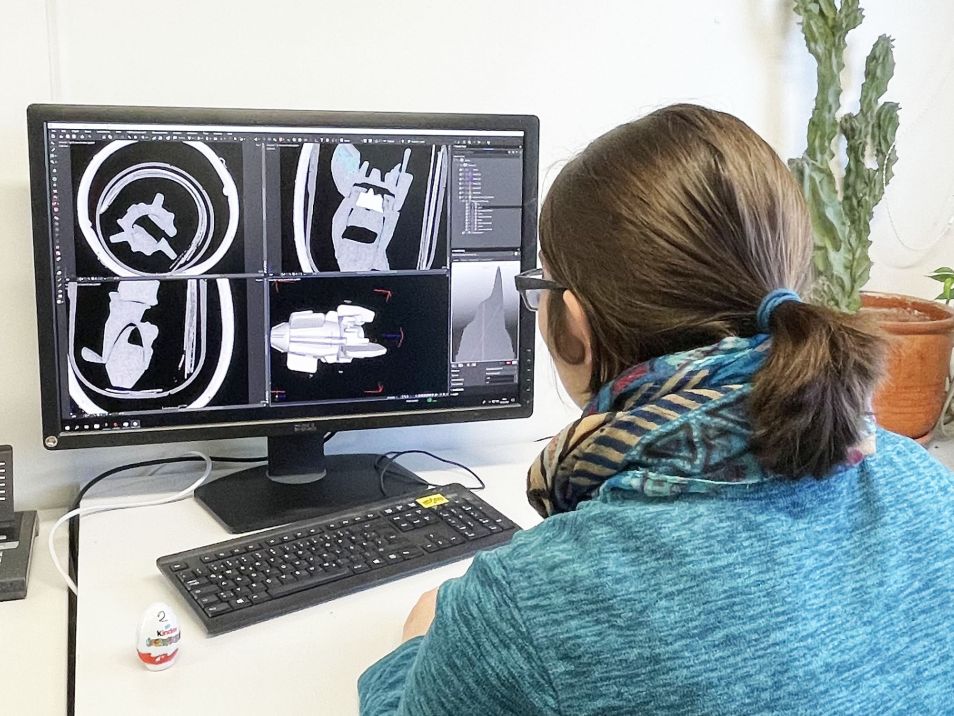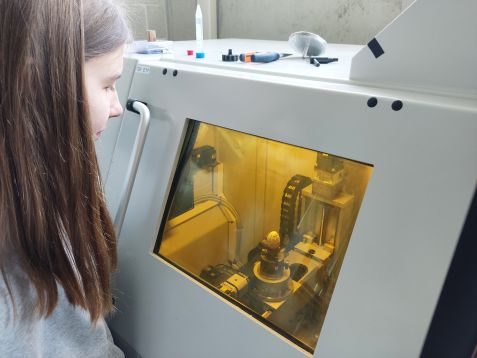MLZ is a cooperation between:
 > Technische Universität München
> Technische Universität München > Helmholtz-Zentrum Hereon
> Helmholtz-Zentrum Hereon
 > Forschungszentrum Jülich
> Forschungszentrum Jülich
MLZ is a member of:
 > LENS
> LENS > ERF-AISBL
> ERF-AISBL
MLZ on social media:

MLZ (eng)
Lichtenbergstr.1
85748 Garching
Ever radiographed a surprise egg? – An internship at the MLZ
Rebuilding the inside of a surprise egg without ever having opened the egg? This is possible? Yes, Felicia Calzada and Anna Senyshyn managed it during their internship at the Heinz Maier-Leibnitz Zentrum (MLZ) in Garching. The pupils enthusiastically present their results. The topic of their internship: non-destructive material testing.
On the way to the measuring instrument, Felicia’s supervisor, Alex Gustschin, research associate at the MLZ, explains the methods of nondestructive testing: “To know what’s inside an object without opening it, computed tomography is used.” In a room full of humming equipment is the radiography scanner used for this purpose. Behind a small, transparent window, Alex Gustschin places the test objects between the beam source and the detector.
“Only when the window is closed can you radiograph at all. This is for safety reasons,” Alex Gustschin points out. Felicia Calzada, brought the test objects herself: a pine cone, the surprise egg and a snail shell. In addition, electrical devices are examined, such as a cell phone, Felicia’s toothbrush and a wireless earphone. Felicia Calzada and her supervisors enthusiastically analyze the individual components. Together, they identified the battery, speaker and charging contact in the radiograph of the earphone.
The truck in the egg
Anna Senyshyn and her supervisor Dominik Petz, from the group around the instrument SPODI, also x-ray exciting objects: a Lindt chocolate, a Raffaelo and an Early Bronze Age bone toggle with pewter pins from the Munich State Archaeological Collection. A surprise egg also becomes a test object. Anna Senyshyn watches intently as the egg turns while 3D images are recorded using computer tomography (CT). Later, she reconstructs the small figure inside the egg and clearly recognizes a small truck.
3D model using computed tomography
At the MLZ, researchers use radiography with X-rays or neutrons to examine a sample, depending on its material. Sometimes also both. In the future, this will even be possible simultaneously at the ANTARES imaging instrument for radiography and tomography.
Individual radiography represents represent only a shadow image of the object, while CT offers the possibility of generating 3D images. By rotating the sample, “many slice images are calculated and later reassembled so that we obtain a three-dimensional structure,” explains Alex Gustschin. In a process known as segmentation, the test object can then be broken down into its individual layers with the help of a computer program.

Intern Felcia Calzada together with supervisors Burkhard Schillinger (l.), Alexander Gustschin (2nd from right) and Simon Sebold in the computer lab meeting room. © FRM II / TUM
Favorite subjects: math and physics
You can see Felicia’s enthusiasm for her internship, and it is no coincidence. “My favorite subjects at school are math and physics. In physics, I am particularly interested in the field of nuclear physics. It’s so fascinating because even though you can’t see the particles, they’re around us all the time.”
One of the objects that Felicia Calzada segments is a surprise egg. She proudly presents the shape she isolated from inside the egg using computed tomography and software: a small rocket. “We then put that into the 3D printer,” she says happily. With that, without ever having opened the egg, she was not only able to view the shape inside, but even recreate it.
The surprise egg is still edible after the tomography, but Felicia will keep it at home, along with the 3D prints, as a souvenir of the great internship. Next week, she is going back to school. “I really enjoyed the internship at MLZ. My highlight was isolating and printing the rocket,” the intern says with satisfaction. In addition to Alex Gustschin, the instrument supervisor for ANTARES, Dr. Burkhard Schillinger, and Ph.D. student Simon Sebold also enjoyed the supervision and the short addition to their group.
Other exciting internships provided by the MLZ:

Meike Jahn
Press and public relations
FRM II
MLZ is a cooperation between:
 > Technische Universität München
> Technische Universität München > Helmholtz-Zentrum Hereon
> Helmholtz-Zentrum Hereon
 > Forschungszentrum Jülich
> Forschungszentrum Jülich
MLZ is a member of:
 > LENS
> LENS > ERF-AISBL
> ERF-AISBL
MLZ on social media:




